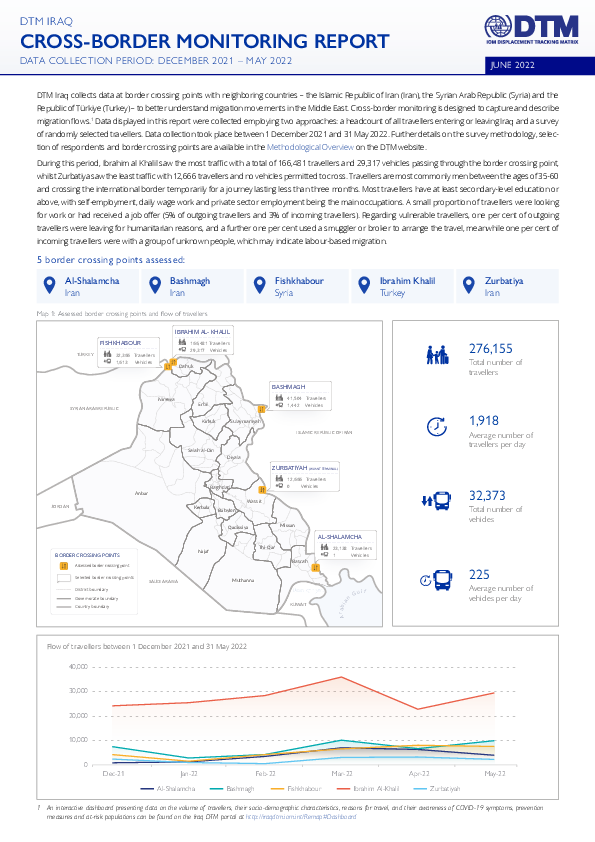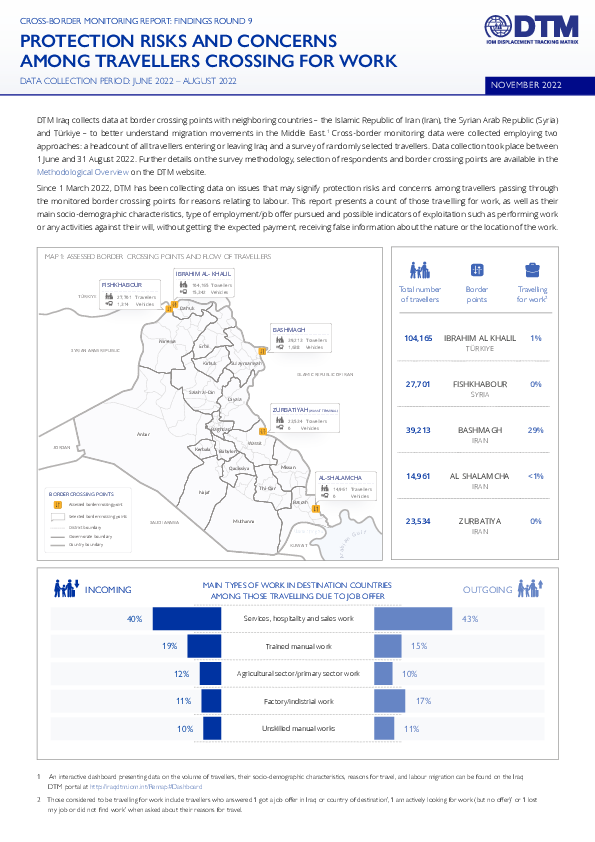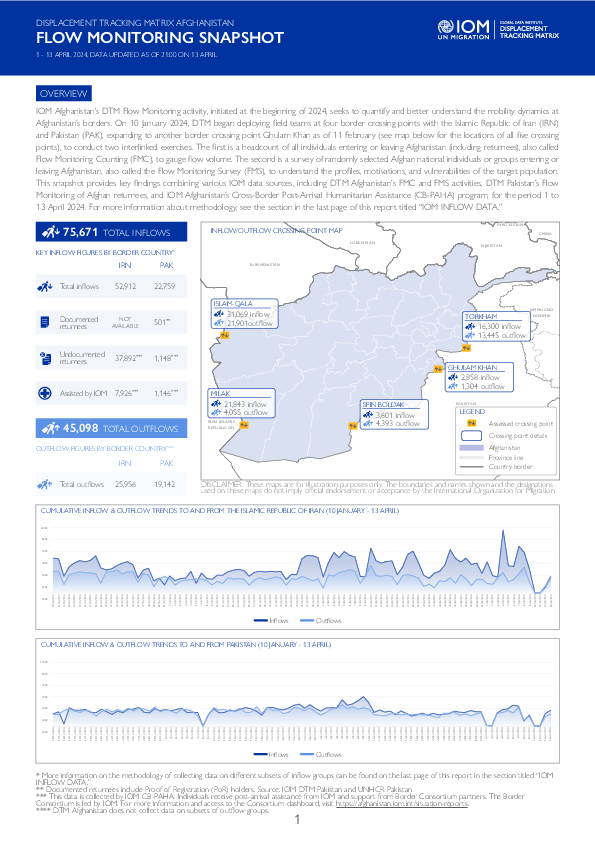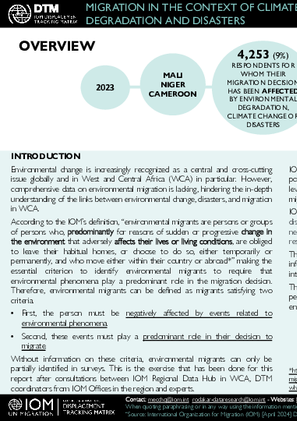-
Countries
-
Data and Analysis
-
Special Focus
-
Crisis Responses
Flow Monitoring

Contact
DTM Pakistan, iomisbdtmremapteam@iom.int
Language
English
Location
Pakistan
Period Covered
Apr 01 2024
Apr 15 2024
Activity
- Flow Monitoring
The International Organization for Migration (IOM) in Pakistan collects data on the outflows of Afghans at the Torkham (Khyber Pakhtunkhwa), Badini, Bahramcha, and Chaman (Balochistan) border crossing points (BCPs) to better understand the movements of Afghans returning to Afghanistan. The data is harmonized with those from the United Nations High Commissioner for Refugees (UNHCR), who also cover the Ghulam Khan (Khyber Pakhtunkhwa) BCP.
On 26 September 2023, the Ministry of Interior in Pakistan announced its decision to enact its “Illegal Foreigners’ Repatriation Plan (IFRP)”. Between 1 and 15 April 2024, a total of 8,261 Afghan nationals returned to Afghanistan, including 6,770 through the Torkham BCP, 877 through the Chaman BCP, and 614 through the Ghulam Khan BCP, while no Afghan nationals returned through the Badini and Bahramcha BCPs. In addition, border authorities deported 71 individuals due to a lack of valid documentation. Since 1 January 2024, IOM identified 62,559 returns at the four BCPs.

Contact
iomguatemala@iom.int
Language
English
Location
Guatemala
Period Covered
Feb 01 2024
Feb 29 2024
Activity
- Flow Monitoring
In Februrary 2024, 22,402 movements were observed in Guatemala (18% children) and 400 individuals were surveyed.1 The number of observed movements decreased by 6 per cent from January 2024 (23,690) due to operational constraints in data collection. More than half of surveyed individuals originated from the Bolivarian Republic of Venezuela (63%). The main intended destination was the United States of America (90%).
Since 2022, migratory flows through the Latin America and Caribbean region have increased significantly, with record levels of persons crossing the perilous jungle of the Darién National Park from Colombia into Panama. The in-transit flows tracked in Guatemala have mirrored these regional migration trends.

Contact
iomguatemala@iom.int
Language
English
Location
Guatemala
Period Covered
Feb 01 2024
Feb 29 2024
Activity
- Flow Monitoring
En febrero de 2024 se observaron 22,402 movimientos en Guatemala (18% niños, niñas y adolescentes) y 400 personas fueron encuestadas.1 El número de movimientos observados disminuyó un 6 por ciento desde enero de 2024 (23,690) debido a limitaciones operativas en la recolección de datos. Más de la mitad de las personas encuestadas procedía de la República Bolivariana de Venezuela (63%). El principal destino previsto fue los Estados Unidos de América (90%).
Desde 2022, los flujos de migrantes en tránsito se incrementaron significativamente en la región de América Latina y el Caribe, observando cantidades nunca antes registradas de personas que cruzan la peligrosa selva del Parque Nacional del Darién desde Colombia hacia Panamá. Los flujos en tránsito observados en Guatemala han reflejado dichas tendencias migratorias regionales

Contact
IraqDTM@iom.int
Language
English
Location
Iraq
Period Covered
Dec 01 2021
May 30 2022
Activity
- Survey
- Flow Monitoring
DTM Iraq collects data at border crossing points with neighboring countries – the Islamic Republic of Iran (Iran), the Syrian Arab Republic (Syria) and the Republic of Türkiye (Turkey) – to better understand migration movements in the Middle East. Cross-border monitoring is designed to capture and describe migration flows. Data displayed in this report were collected employing two approaches: a headcount of all travellers entering or leaving Iraq and a survey of randomly selected travellers. Data collection took place between 1 December 2021 and 31 May 2022. Further details on the survey methodology, selection of respondents and border crossing points are available in the Methodological Overview on the DTM website.
During this period, Ibrahim al Khalil saw the most traffic with a total of 166,481 travellers and 29,317 vehicles passing through the border crossing point, whilst Zurbatiya saw the least traffic with 12,666 travellers and no vehicles permitted to cross. Travellers are most commonly men between the ages of 35-60 and crossing the international border temporarily for a journey lasting less than three months. Most travellers have at least secondary-level education or above, with self-employment, daily wage work and private sector employment being the main occupations. A small proportion of travellers were looking for work or had received a job offer (5% of outgoing travellers and 3% of incoming travellers). Regarding vulnerable travellers, one per cent of outgoing travellers were leaving for humanitarian reasons, and a further one per cent used a smuggler or broker to arrange the travel, meanwhile one per cent of incoming travellers were with a group of unknown people, which may indicate labour-based migration.

Contact
IraqDTM@iom.int
Language
English
Location
Iraq
Period Covered
Dec 01 2022
Feb 28 2023
Activity
- Survey
- Flow Monitoring
DTM Iraq collects data at border crossing points with neighbouring countries – the Islamic Republic of Iran (Iran), the Syrian Arab Republic (Syria) and the Republic of Türkiye (Türkiye) – to better understand migration movements in the Middle East. Cross-border monitoring is designed to capture and describe migration flows. Data displayed in this report were collected employing two approaches: a headcount of all travellers entering or leaving Iraq and a survey of randomly selected travellers. Data collection took place between 1 December 2022 and 28 February 2023. Further details on the survey methodology, selection of respondents and border crossing points are available in the Methodological Overview on the DTM website.
From December 2022 to February 2023, Ibrahim al Khalil saw the most traffic with a total of 90,586 travellers and 16,864 vehicles passing through the border crossing point, whilst Al-Shalamcha saw the least traffic with 6,149 travellers and no vehicles permitted to cross. Most travellers were males and middle-aged (35–60 years old) crossing an international border for a journey lasting less than three months. The majority of travellers have a secondary or vocational education degree, with self-employment and private sector employment being the main employment statuses. A small proportion of travellers were looking for work or had received a job offer (6% of incoming travellers and 4% of outgoing travellers). Regarding protection risks, one per cent of travellers entered Iraq for humanitarian reasons, and less than one per cent entered Iraq with a group of unknown people. It was observed that the number of people crossing the border drastically dropped a day after a 7.8 magnitude earthquake struck on 6 February 2023. The border monitoring team also reported various types of vehicles transporting relief for people affected by the Earthquake in Türkiye and Syria crossing Ibrahim Al-Khalil border point.

Contact
IraqDTM@iom.int
Language
English
Location
Iraq
Period Covered
Jun 01 2022
Aug 31 2022
Activity
- Survey
- Flow Monitoring
DTM Iraq collects data at border crossing points with neighboring countries – the Islamic Republic of Iran (Iran), the Syrian Arab Republic (Syria) and Türkiye – to better understand migration movements in the Middle East.1 Cross-border monitoring data were collected employing two approaches: a headcount of all travellers entering or leaving Iraq and a survey of randomly selected travellers. Data collection took place between 1 June and 31 August 2022. Further details on the survey methodology, selection of respondents and border crossing points are available in the Methodological Overview on the DTM website.
Since 1 March 2022, DTM has been collecting data on issues that may signify protection risks and concerns among travellers passing through the monitored border crossing points for reasons relating to labour. This report presents a count of those travelling for work, as well as their main socio-demographic characteristics, type of employment/job offer pursued and possible indicators of exploitation such as performing work or any activities against their will, without getting the expected payment, receiving false information about the nature or the location of the work.

Contact
IraqDTM@iom.int
Language
English
Location
Iraq
Period Covered
Sep 01 2022
Nov 30 2022
Activity
- Survey
- Flow Monitoring
DTM Iraq collects data at border crossing points with neighboring countries – the Islamic Republic of Iran (Iran), the Syrian Arab Republic (Syria) and the Republic of Türkiye (Türkiye) – to better understand migration movements in the Middle East. Cross-border monitoring data were collected employing two approaches: a headcount of all travellers entering or leaving Iraq and a survey of randomly selected travellers. Data collection took place between 1 September and 30 November 2022. Further details on the survey methodology, selection of respondents and border crossing points are available in the Methodological Overview on the DTM website.
Following previous period, DTM team continuing its efforts of collecting data on issues that may signify protection risks and concerns among travellers passing through the monitored border crossing points for reasons relating to labour. This report presents a count of those travelling for work, as well as their main socio-demographic characteristics, type of employment/job offer pursued and possible indicators of exploitation such as performing work or any activities against their will, without getting the expected payment, receiving false information about the nature or the location of the work.

Contact
IraqDTM@iom.int
Language
English
Location
Iraq
Period Covered
Dec 01 2022
Feb 28 2023
Activity
- Survey
- Flow Monitoring
DTM Iraq collects data at border crossing points with neighboring countries – the Islamic Republic of Iran (Iran), the Syrian Arab Republic (Syria) and the Republic of Türkiye (Türkiye) – to better understand migration movements in the Middle East. Cross-border monitoring data were collected employing two approaches: a headcount of all travellers entering or leaving Iraq and a survey of randomly selected travellers. Data collection took place between 1 December 2022 and 28 February 2023. Further details on the survey methodology, selection of respondents and border crossing points are available in the Methodological Overview on the DTM website.
As part of this activity, the DTM team continued its efforts to collect data on issues that may signify protection risks and concerns among travellers passing through the monitored border crossing points for labour-related reasons. This report presents a count of those travelling for work, as well as their main socio-demographic characteristics, type of employment/job offer pursued and possible indicators of exploitation such as performing work or any activities against their will, without getting the expected payment or receiving false information about the nature or the location of the work.

Contact
DTMAfghanistan@iom.int
Language
English
Location
Afghanistan
Period Covered
Apr 01 2024
Apr 13 2024
Activity
- Survey
- Flow Monitoring Survey
- Flow Monitoring
IOM Afghanistan's DTM Flow Monitoring activity, initiated at the beginning of 2024, seeks to quantify and better understand the mobility dynamics at Afghanistan’s borders. On 10 January 2024, DTM began deploying field teams at four border crossing points with the Islamic Republic of Iran (IRN) and Pakistan (PAK), expanding to another border crossing point Ghulam Khan as of 11 February (see map below for the locations of all five crossing points), to conduct two interlinked exercises. The first is a headcount of all individuals entering or leaving Afghanistan (including returnees), also called Flow Monitoring Counting (FMC), to gauge flow volume. The second is a survey of randomly selected Afghan national individuals or groups entering or leaving Afghanistan, also called the Flow Monitoring Survey (FMS), to understand the profiles, motivations, and vulnerabilities of the target population. This snapshot provides key findings combining various IOM data sources, including DTM Afghanistan’s FMC and FMS activities, DTM Pakistan’s Flow Monitoring of Afghan returnees, and IOM Afghanistan’s Cross-Border Post-Arrival Humanitarian Assistance (CB-PAHA) program, for the period 1 to 13 April 2024. For more information about methodology, see the section in the last page of this report titled “IOM INFLOW DATA.”
Environmental change is increasingly recognized as a central and cross-cutting issue globally and in West and Central Africa (WCA) in particular. However, comprehensive data on environmental migration is lacking, hindering the in-depth understanding of the links between environmental change, disasters, and migration in WCA.
According to the IOM’s definition, “environmental migrants are persons or groups of persons who, predominantly for reasons of sudden or progressive change in the environment that adversely affects their lives or living conditions, are obliged to leave their habitual homes, or choose to do so, either temporarily or permanently, and who move either within their country or abroad” making the essential criterion to identify environmental migrants to require that environmental phenomena play a predominant role in the migration decision.
This first dashboard aims at providing detailed information and evidence on people on the move in the context of disasters, climate change, and environmental degradation.
Pagination
- Previous page
- Page 17
- Next page
